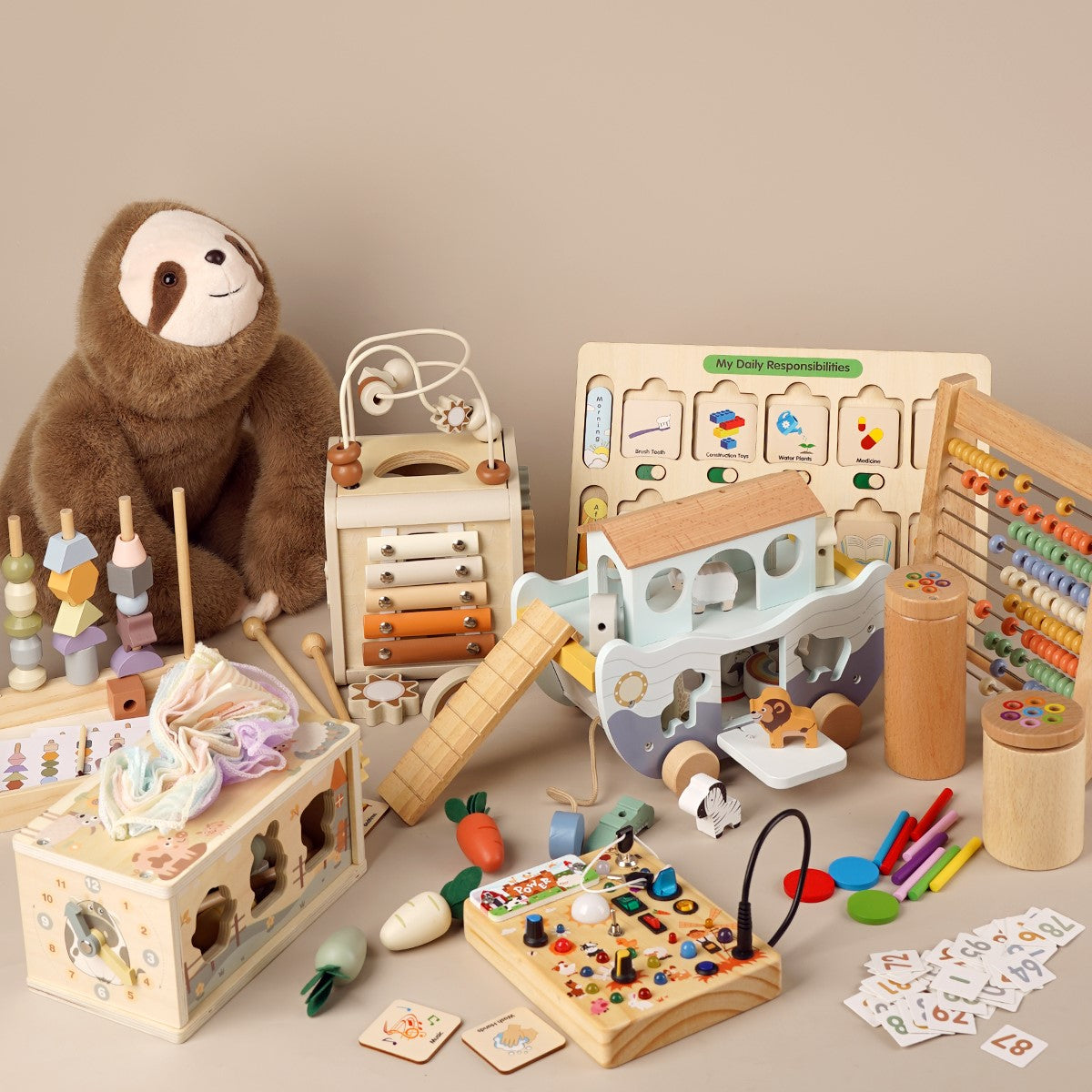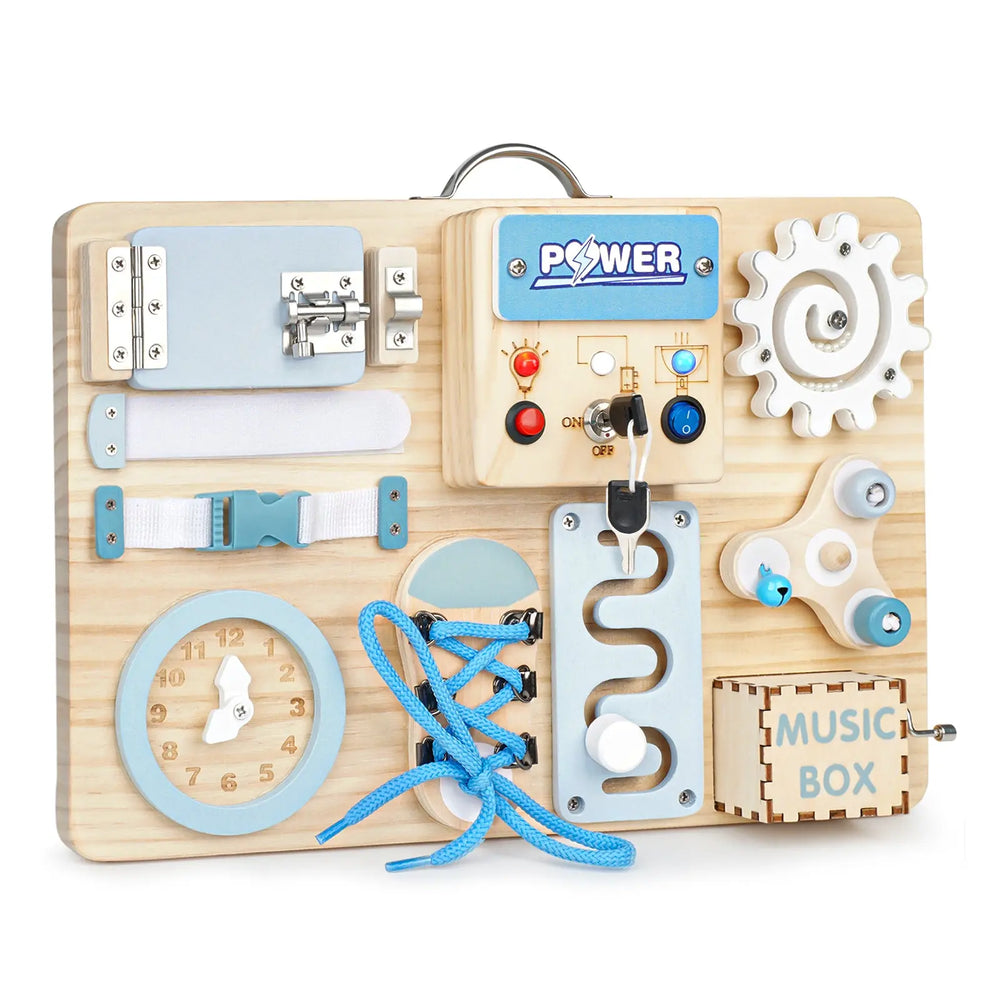How a Montessori Busy Board is Helping Child Develop Key Skills

As parents, we’re always on the lookout for ways to keep our kids engaged, learning, and having fun—especially when they’re full of boundless energy and curiosity. Enter the Montessori busy board: a simple yet powerful tool that not only keeps children entertained but also fosters their development in a hands-on, interactive way. Inspired by the Montessori method of education, which emphasizes independent learning, the busy board is designed to promote fine motor skills, problem-solving, and creativity.
How Nataliia_Shabak’s Child is Mastering Hand-Eye Coordination with a Montessori Busy Board
Have you ever seen a child so engrossed in play that it seems like time just stands still? That’s exactly what happens when children interact with a Montessori busy board. These interactive boards are not just toys—they are learning tools that help children develop critical skills, such as fine motor abilities and hand-eye coordination, all while having fun. One example that beautifully showcases the power of the busy board comes from the Instagram user Nataliia_Shabak, whose child is a perfect example of how busy boards can enhance a child’s physical and cognitive development.
What’s on a Busy Board?
A Montessori busy board is a tactile toy filled with a variety of objects that children can manipulate—like zippers, buttons, knobs, and switches. The beauty of these toys lies in their simplicity. They focus on everyday skills that children need to master, like fastening, turning, pulling, and pushing. These actions, while small, are essential for developing hand-eye coordination, problem-solving abilities, and concentration.
In the video or images shared by Nataliia_Shabak, we can see her little one intently focused on a busy board. The child is experimenting with various parts of the board—zipping up a zipper, turning a knob, or pressing a switch. The focus on her face as she works through each task is evident, and every small success seems to bring a smile of accomplishment. It's not just about completing a task; it's about the process, the learning, and the satisfaction of overcoming a challenge.
Developing Hand-Eye Coordination Through Play
What makes these moments so fascinating is how they showcase a child’s developing hand-eye coordination. At a young age, fine motor skills are still developing, and activities like manipulating small objects help build strength and dexterity in the hands and fingers. By actively engaging with a busy board, children improve their ability to control their hand movements and match them with what they see.
In Nataliia_Shabak’s video, you can see her child using both hands in a fluid, deliberate manner. Whether it’s trying to open a difficult latch or carefully threading something through a hole, every action helps strengthen neural connections between the brain and the body. The beauty of this play is that it feels natural to the child—they’re not just "learning" in the traditional sense, but rather learning through discovery, curiosity, and practice.
The Power of Focus and Patience
Another striking element in the video is the child’s concentration and patience. Watching her focus on the task at hand demonstrates how engaging these busy boards can be. The process of figuring out how to make the zippers zip or the knobs turn might seem trivial to us, but to a young child, it's a massive achievement that requires sustained attention. Each little movement is a chance to practice control, testing out different strategies, and solving problems.
This focus is incredibly important for a child’s development. It teaches them how to concentrate, how to stay engaged with a task, and how to deal with frustration when things don’t work as expected. As the child continues to engage with the busy board, she’s building not only motor skills but also the mental and emotional resilience needed to overcome challenges in the future.
The Cognitive and Emotional Benefits
The best part about the Montessori busy board is that it’s not just about developing physical skills. These hands-on activities also have profound cognitive and emotional benefits. Problem-solving skills are nurtured as children explore how different parts of the busy board function. They make connections between actions and results, which helps lay the groundwork for more complex thinking in the future.
Emotionally, completing tasks on the busy board boosts a child’s self-esteem. There’s a sense of satisfaction that comes with every completed action, which fosters a growth mindset. Children learn that effort leads to success, a lesson that is crucial for lifelong learning.
Why Montessori Busy Boards Are Essential for Early Development
Incorporating Montessori-inspired activities, such as busy boards, into early childhood playtime is a fantastic way to promote interactive learning. They not only keep children occupied but also give them the chance to practice skills that will serve them for a lifetime.
Children like Nataliia_Shabak’s little one are being guided toward building essential life skills in an organic, enjoyable way. While they may not even realize it, every movement and every successful task on the busy board helps them refine skills they’ll use for years to come—whether that’s zipping their jacket, fastening their shoes, or developing the focus needed to solve complex problems.
What Can We Learn from Nataliia_Shabak’s Child?
Watching children like Nataliia_Shabak’s engage so deeply with a Montessori busy board can be a reminder of just how powerful play can be in a child's development. Their concentration, persistence, and ability to solve problems through hands-on experience offer valuable lessons for parents and educators alike.
Have you ever observed a child engaging with a busy board? Whether it’s your own child or someone else’s, the development of focus and fine motor skills is awe-inspiring. The quiet dedication children bring to these activities can remind us of the importance of hands-on learning and how even simple toys can offer profound developmental benefits.
If you’ve had similar experiences or if you’ve used a busy board with your child, feel free to share your thoughts and observations. What’s the most impressive skill you’ve seen your child develop through hands-on play? Let’s keep the conversation going and share ideas for supporting our kids’ growth in a fun and engaging way!
Final Tips for a Montessori-Inspired Busy Board
- Keep it simple: You don’t need a ton of items to make the board effective. A few engaging activities will suffice.
- Encourage independence: Let your child explore the busy board on their own as much as possible.
- Safety first: Ensure that all items are securely fastened and do not pose any choking hazards.
- Adapt as they grow: As your child’s abilities improve, you can swap out items for more challenging ones to keep them engaged.

Maybe it will be helpful for you:
Recent Post

From Letters to Language: Helping Nonverbal Kids Communicate with Joyreal AAC
Many parents notice something fascinating: “My child doesn’t talk b...

Buy Once, Play Longer with Joyreal Toys
“We’re tired of toys that only last a weekend.”“I want toys that gr...

Love Is Learning Together: Valentine’s Day Educational Toys by Joyreal
When we think of Valentine’s Day, our minds often drift to roses, c...

A New Year, A New Beginning: Joyreal Toys’ Wish for Every Child
A Heartfelt New Year Message from Joyreal Toys As we welcome 2026, ...

Can Montessori Wooden Toys Grow With Your Child From 1 to 4?
When Your One-Year-Old Plays for Two Minutes and Walks Away It’s a ...

Mini Piano or Drum Set — Which Is Best for Kids?
As parents, we all face the same struggle — our children spend hour...

Is Phonics-Based AAC Right for Your Nonverbal Child?
Why Nonverbal Children Need AAC Devices For many parents, finding a...

Picture-Based AAC or Phonics AAC? A Parent’s Guide
Phonics vs Picture-Based AAC: Which Communication Tool Is Right for...

How Does Music Enlightenment Work for Ages 0–3?
Why Age-Specific Music Enlightenment Matters (0–3 Years) The first...

What Age Is a Noah’s Ark Toy For?
Is a Noah’s Ark Toy Good for Toddlers (Ages 1, 2 & 3)? When par...










